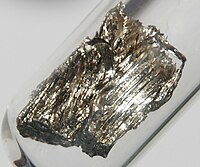
Photo from wikipedia
Sintered Nd–Pr–Dy–Fe–B permanent magnets were prepared by a powder blending technique using mixtures consisting of strip-casting alloy (wt %) 24.0 Nd, 6.5 Pr, 0.5 Dy, 1.0 B, 0.2 Al, 65.8… Click to show full abstract
Sintered Nd–Pr–Dy–Fe–B permanent magnets were prepared by a powder blending technique using mixtures consisting of strip-casting alloy (wt %) 24.0 Nd, 6.5 Pr, 0.5 Dy, 1.0 B, 0.2 Al, 65.8 Fe and 2 wt % DyH2 dysprosium hydride. After optimum heat treatment of magnets at 500°C for 1 h, the following hysteretic characteristics were reached: remanence Br = 1.29 T; coercive force jHc = 1309 kA/m; critical field Hk = 1220 kA/m; and the maximum energy product (BH)max = 322 kJ/m3. The characteristic peculiarity of the magnets prepared from hydride-containing power mixtures is the stability of hysteretic properties in the course of subsequent stepped annealings or progressive heatings at temperatures of 250–500°C for, in total, more than 20 h. Conditions of low-temperature annealings resulting in the degradation and subsequent restoration of hysteretic properties of magnets are determined. The evolution of the microstructure and phase composition of magnets in the course of heat treatments was studied by X-ray diffraction analysis and scanning electron microscopy, and the correlation between the structural changes and hysteretic properties of magnets is discussed.
Journal Title: Inorganic Materials: Applied Research
Year Published: 2018
Link to full text (if available)
Share on Social Media: Sign Up to like & get
recommendations!